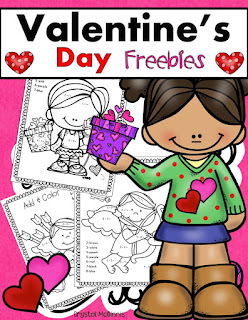Welcome to the I Teach Kindergarten linkup! My name is Crystal McGinnis and I am a kindergarten teacher in a small Missouri school district. Winter is well underway, and although it has not felt like winter yet (temps in the 60's), I would like to share with you one of the lessons that I will use in my kindergarten classroom following winter break. I hope you can use some of these ideas in your own classroom. Check back next month for more kindergarten classroom ideas!

This year, one of the goals that I have for my kindergarten classroom is to provide more shared reading experiences for my kindergarten kids. My school has implemented a very rigorous balanced literacy program, and shared reading is a very crucial and important part of our day. Generally, I love to use big books for shared reading, but sadly I don't always have a big book to use that ties into the theme that I am teaching. Some weeks, instead of a big book, I use poems for shared reading. This has really proved to be a positive reading experience for my kids! I usually use the same poem for 3 to 4 days each week during our shared reading time. Each day, we do something different with the poem. By the end of the week, my kids have learned several new words, and have practiced many important reading skills including concepts of print, rhyme, making connections, and so much more. The following is a glimpse into how I use a poem for shared reading in my classroom.
Day 1 is my introduction to the poem. I usually introduce a poem by providing a time for my kids to make predictions about what they think our poem will be about. For this poem, I will bring in some items that you would put on a snowman (such as a hat, scarf, sticks, carrot, etc), and pull them out one item at a time. As each item is pulled out, we will make our predictions. After we have made our predictions and connections, I then provide my kids with a copy of the poem that we will be reading. Each student in my class has a clipboard, so they attach the poem to their clipboard and join me "on the carpet" to begin sharing the poem. I display the poem with my projector and with an anchor chart. (Depending on how much prep time that I have). On day 1, we read the poem a few times and then begin to study parts of the poem including concepts of print, sight words, cvc words, rhyming words etc. We use our highlighters (or yellow crayons) to highlight these concepts as we find them.

Some weeks, I write the poems on chart paper. These are perfect to display around my classroom so that my kids can use them later as a tool in their writing. Once every few weeks, we go back and read all of our poems. Most of them are "catchy" enough that they are usually turned into a song. I am thinking that these songs/poems would be perfect to sing at our end of the year parent night. We may take a "glance back" at our year using songs!
After our poem introduction, I follow up the poem with a word work activity that includes words from the poem. This poem had a few words from the "at family," so this will be my focus. We will write our "at words" on the white boards that I picked up at Dollar Tree. We will draw sound boxes to practice breaking apart the words into the sounds that we hear. We will then build "at words" using our letter tiles.
On day 2, I re-use the same poem again to build fluency. I try to change my routine on day two. This time the poem is missing words. We work together to fill in the missing words. I usually display the poem with my projector, and the kids place their copy on their clipboard. We fill in the missing words together. Some of the missing words are our "sight words," while some of the other missing words are cvc words.
On day 3, my students help me build the same poem again in our pocket chart. I pass out the words, and they come up one at a time and put their word in the pocket chart as we say the poem. I am always amazed at how many words they can now identify from the poem by day 3. After they have helped me build the poem, I place the poem (laminated and cut into individual words) into my working with words center. My kids put it together independently while I am completing my guided reading groups.
After day 3, the kids will place their poem in their poetry notebook. We pull out these notebooks during our "read to self" time. Our notebooks have become valuable familiar reading materials.
You are welcome to use this poem in your own classroom! If you would like the versions of the poem that I have shown above, click the picture below. I have included this poem as a freebie in the preview. Enjoy!



















































